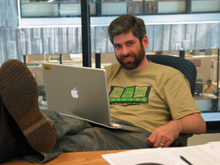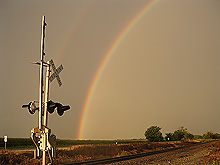 |
Monday, September 11
2:30 p.m. Particle Astrophysics Seminar - Curia II
Speaker: C. Gordon, University of Chicago
Title: Broken Isotropy from a Linear Modulation of the
Primordial Perturbations
3:30 p.m. DIRECTOR'S COFFEE BREAK - 2nd Flr X-Over
4:00 p.m. All Experimenters' Meeting - Curia II
Special Topic: COUPP Bubble Chamber Test
Tuesday, September 12
11:00 p.m. Computing Techniques Seminar - FCC 1
Speaker: T. Johnson, Stanford Linear Accelerator Center
Title: A Comprehensive Java-Based Simulation Environment
for Particle Physics
3:30 p.m. Director's Coffee Break - 2nd floor crossover
THERE WILL BE NO ACCELERATOR PHYSICS AND TECHNOLOGY
SEMINAR TODAY
Click here for a full calendar with links to additional information.
|



Monday, September 11
-French Quarter Gumbo
-French Dip w/Horseradish Cream Sauce
-Santa Fe Pork Stew
-BBQ Roasted Quartered Chicken
-Turkey Breast on Homemade Fococcia
-Assorted Slice Pizza
-Sweet n' Sour Chicken w/an Egg Roll
The Wilson Hall Cafe accepts Visa, Master Card, Discover and American Express. Wilson Hall Cafe Menu |

Wednesday, September 13
Lunch
-Lebanese Kabob w/Pita
-Baba Ghannuj
-Hummus
-Tabbouli
-Baklava
Thursday, September 14
Dinner
-Puree Gloria
-Grilled Jumbo Shrimp
-Angel Hair Pasta Diavolo
-Sautéed Spinach w/Bacon
-Profiteroles
Chez Leon Menu
Call x4598 to make your reservation. |


|
 |
| Hooper to publish popular book with Harper Collins
|
 |
|
To be released on November 1 by Harper Collins Publishers, Dan Hooper's book strives to illustrate the big questions of modern physics.
|
|
|
Dan Hooper, a theoretical astrophysicist at Fermilab, has attempted to make modern physics accessible in his soon-to-be released popular science treatment of Dark Cosmos - In Search of Our Universe's Missing Mass and Energy. "I owe my career in physics to such popular books," said Hooper, who first became interested in physics after reading a popular book about string theory in college. "I wanted to give something back and maybe inspire others."
To be released on November 1 by Harper Collins Publishers, Hooper's book strives to illustrate the big questions of modern physics. The book begins at the largest scales: the universe as a whole and the evidence for the existence of dark matter and energy. It continues to a description of what scientists know - the Standard Model - and outlines theories that may resolve unanswered questions: the Higgs, string theory and Supersymmetry. "There is some explanation of methods of observation or experiments, but what I love are the concepts, so that is the focus," said Hooper.
As an undergraduate, Hooper was unsure of his career direction until he took a modern physics course. Classtime only piqued his curiosity, so a professor loaned him Superstrings by Paul Davies, the first of many popular science books he has read and continues to read. "I still read these books - no longer for information, but for inspiration. It's easy to get lost in the math that is most of what I do, but these books remind me that the universe is an amazing and awe-inspiring place."
--Benjamin Berger
|

CERN Courier,
September 7, 2006:
Ray Davis: indefatigable neutrino pioneer
Peter Rosen looks back at the man who brought his deft chemical touch to the study of neutrinos, and created one of the iconic experiments of the 20th century.
Raymond Davis Jr, discoverer and grand pioneer of
 |
| Raymond Davis |
the solar-neutrino problem, died on 31 May at the venerable age of 91. In 1968 he discovered the solar-neutrino anomaly and more than three decades later he received the 2002 Nobel Prize in Physics. This followed other experiments based on different techniques, which demonstrated that the anomaly was neither an artifact of his experiment nor an error in the late John Bahcall's theoretical calculations of the neutrino flux from the Sun; it was indeed a real physical effect. Simultaneously, Davis had shown that the Sun generates its energy by nuclear fusion of hydrogen into helium, and that the electron-type neutrinos created in this process change into other types of neutrino during their eight minute journey to Earth.
His vehicle was a nuclear reaction suggested by Bruno Pontecorvo in 1946: a neutrino captured by a specific isotope of chlorine produces an electron and a radioactive isotope of argon. Sources of chlorine were plentiful and cheap, and argon, a noble gas, could easily be extracted from a chlorine solution. Davis counted the atoms of the argon isotope by observing the decay back to chlorine. Over the years, he tested and refined the method so that it became totally reliable as a procedure for measuring even a tiny number of argon atoms produced in Pontecorvo's chlorine reaction.
Read More
Author S. Peter Rosen is
 |
| Peter Rosen |
a senior science advisor for the Office of Science, US Department of Energy. He is on temporary assignment to the National Science Foundation.
|
|
 |

| New dosimeter |
 |
| Fermilab will adopt a new type of radiation dosimeter on October 1. The old TLD badge (left) is shown here next to the new OSL badge. |
On October 1, Fermilab will adopt a new type of radiation dosimeter. With the old badge, beta/gamma radiation is detected with thermoluminescent dosimeters (TLD) made of lithium fluoride. In the new badge, this function is accomplished using optically stimulated luminescence (OSL) from aluminum oxide. Both old and new badges use CR-39 polycarbonate to measure neutron exposure.
OSL represents a recent advancement in passive radiation dosimetry. During processing, the aluminum oxide sensing elements are illuminated with an array of LEDs, causing them to luminesce in proportion to the amount of ionizing radiation received. OSL dosimetry has a number of advantages over TLDs, including the ability to re-read sensing elements at times when results are questionable.
If you are required to wear a radiation dosimeter, the proper usage rules remain the same:
Exchange your dosimeter at the start of each quarter - January 1, April 1, July 1 and October 1.
Wear your dosimeter on the front of your body between your neck and waist.
Do not leave your dosimeter in a radiological area.
Do not wear your dosimeter when receiving dental or medical X-rays or radioisotope treatments.
Do not launder your dosimeter.
Safety Tip of the Week Archive
|

 |
| AD's Daren Plant took this picture Monday evening, about 4 miles West of Big Rock, Illinois. "I decided to get off of Route 30 because people traveling East were looking at this rainbow instead of what lane they were driving in!" he wrote.
|
|
 |
Annual benefits enrollment
Annual benefits enrollment is coming soon. You will receive your annual enrollment packet via your mail station before September 30.
Attention emergency wardens
It's time for the annual emergency warden training. Please select from the following dates and sign up on the ES&H website: Wednesday, September 13 from 9:30 a.m. to 10:30 a.m. in 1 West, or Thursday, September 14, from 9:30 a.m. to 10:30 a.m. in 1 West.
NALWO Picnic
NALWO will hold a fall picnic on September 15, from 5:30 to 8:00 p.m. just outside the Kuhn Barn. Meet friendly lab families and join us for an evening of supper and games. Children are welcome; each family gets a Fermilab Frisbee.
Please bring food to grill, and a dish to share among 8 people, such as a casserole, salad or side dish.
NALWO will provide charcoal grills, plates and cutlery, soft drinks and desserts.
For additional information, contact the Housing Office, 630/840-3777 or housing@fnal.gov; Rose Moore, 630/208-9309 or Christiane Albrow, 630/717-8906.
Scottish Country Dancing
Scottish Country Dancing will meet Tuesday, September 12, in Kuhn Barn in the Village. Instruction begins at 7:30 p.m. and newcomers are always welcome. Most dances are fully taught and walked through, and you do not need to come with a partner. Info at 630-840-8194 or 630-584-0825 or folkdance@fnal.gov.
Upcoming Activities |
|





